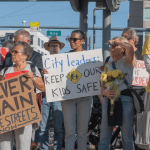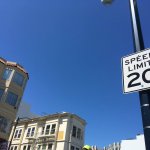Summer reading: two books look at how those who don’t drive are often undervalued
Growing up in San Francisco, getting around on foot and transit was the default option for me. Living in a high-density city meant that most of my destinations weren’t far from home, and the extensive Muni system got me everywhere else.
But this isn’t the reality in many – in fact most – parts of our state and country. Instead, driving a private vehicle is often the only safe and convenient way to get around. So for the one-third of Americans who don’t drive, this can mean extremely dangerous walking conditions and many more inequities.
Even here in San Francisco, many streets are designed to prioritize fast-moving traffic rather than those of us outside of private vehicles.
On June 3, I attended an author talk hosted by SPUR with disability advocate Anna Letitia Zivarts. Zivarts’ book, When Driving Is Not an Option: Steering Away from Car Dependency, draws on her experience as a low-vision parent and opens our eyes to the experiences of involuntary nondrivers, the majority of which are youth, older adults, lower income, people with disabilities, unhoused, formerly incarcerated, undocumented, or a combination of the above categories.
Too often, those who don’t drive have been left behind in many transportation decisions and priorities. This can keep too many people from being able to get where they need to go, limiting opportunities and also creating social isolation.
Zivarts contrasted her experience growing up in a rural town where she relied on others for rides to living in New York City, where a strong subway system empowered her to make trips independently and gain a sense of belonging.
Zivarts brings up an issue that was echoed in another book I recently read, Inclusive Transportation: A Manifesto for Repairing Divided Communities by Veronica Davis. Davis points out how people who get around not in a car are undervalued, undercounted, and under-supported in how cities are designed. Black, Brown, and low-income people have often borne the brunt of destructive transportation projects (especially freeway-building), adding to this harmful inequity.
Add to this what Zivarts points out: nondrivers from marginalized communities are the most likely to be excluded from decision-making processes, which means their needs and concerns frequently fall by the wayside.
That’s where you, me, and Walk SF come in to bring in the voices of pedestrians of all ages, abilities, and backgrounds. We must make walking safe, supported, and seen here in San Francisco and beyond.
Both When Driving Is Not an Option: Steering Away from Car Dependency and Inclusive Transportation: A Manifesto for Repairing Divided Communities bring essential learnings and reflections on what it means to be a pedestrian and a pedestrian advocate. Both books also highlight how interconnected transportation planning and traffic violence are, making clear that equity must be at the core of how we decide the future of streets and cities. Let me know what you think if you read either book at fiona@walksf.org.
Banner image: Michael Halberstadt




